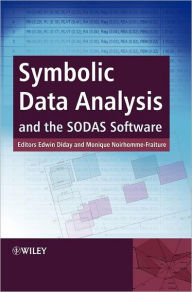
Symbolic Data Analysis and the SODAS Software / Edition 1
by Edwin Diday
Classical statistical techniques are often inadequate when it comes to analysing some of the large and internally variable datasets common today. Symbolic Data Analysis (SDA) has evolved in response to this problem and is a vital tool for summarizing information in such a way that the resulting data is of a manageable size. Symbolic data, represented by
intervals
… See more details belowOverview
Classical statistical techniques are often inadequate when it comes to analysing some of the large and internally variable datasets common today. Symbolic Data Analysis (SDA) has evolved in response to this problem and is a vital tool for summarizing information in such a way that the resulting data is of a manageable size. Symbolic data, represented by
intervals, lists, histograms, distributions, curves and the like, keeps the "internal variation" of summaries better than standard data. SDA therefore plays a key role in the interaction between statistics and data processing, and has established itself as an important tool for analysing official statistics.
Through an extension of the concepts employed in data mining, the Editors provide an advanced guide to the techniques required to analyse symbolic data. Contributions from leading experts in the field enable the reader to build models and make predictions about future events.
The book:
Symbolic Data Analysis and the SODAS Software is primarily aimed at practitioners of symbolic data analysis, such as statisticians and economists, within both the public and private sectors. There is also much of interest to postgraduate students and researchers within web mining, text mining, and bioengineering.
Product Details
- ISBN-13:
- 9780470018835
- Publisher:
- Wiley
- Publication date:
- 03/25/2008
- Pages:
- 476
- Product dimensions:
- 6.81(w) x 9.88(h) x 1.04(d)
Table of Contents
Contributors.
Foreword.
Preface.
ASSO Partners.
Introduction.
1. The state of the art in symbolic data analysis: overview and future (Edwin Diday).
PART I. DATABASES VERSUS SYMBOLIC OBJECTS.
2. Improved generation of symbolic objects from relational databases (Yves Lechevallier, Aicha El Golli and George Hébrail).
3. Exporting symbolic objects to databases (Donato Malerba, Floriana Esposito and Annalisa Appice).
4. A statistical metadata model for symbolic objects (Haralambos Papageorgiou and Maria Vardaki).
5. Editing symbolic data (Monique-Noirhomme-Fraiture, Paula Brito, Anne de Baenst-Vandenbroucke and Adolphe Nahimana).
6. The normal symbolic form (Marc Csernel and Francisco de A.T. de Carvalho).
7. Visualization (Monique-Noirhomme-Fraiture and Adolphe Nahimana).
PART II. UNSUPERVISED METHODS.
8. Dissimilarity and matching (Floriana Esposito, Donato Malerba and Annalisa Appice).
9. Unsupervised divisive classification (Jean-Paul Rasson, Jean-Yves Pirçon, Pascale Lallemand and Séverine Adans).
10. Hierarchical and pyramidal clustering (Paula Brito and Francisco de A.T. de Carvalho).
11 .Clustering methods in symbolic data analysis (Francisco de A.T. de Carvalho, Yves Lechevallier and Rosanna Verde).
12. Visualizing symbolic data by Kohonen maps (Hans-Hermann Bock).
13 .Validation of clustering structure: determination of the number of clusters (André Hardy).
14. Stability measures for assessing a partition and its clusters: application to symbolic data sets (Patrice Bertrand and Ghazi Bel Mufti).
15. Principal component analysis of symbolic data described by intervals (N.Carlo Lauro, Rosanna Verde and Antonio Irpino).
16. Generalized canonical analysis (N.Carlo Lauro, Rosanna Verde and Antonio Irpino).
PART III .SUPERVISED METHODS.
17. Bayesian decision trees (Jean-Paul Rasson, Pascale Lallemand and Séverine Adans).
18. Factor discriminant analysis (N.Carlo Lauro, Rosanna Verde and Antonio Irpino).
19. Symbolic linear regression methodology (Filipe Afonso, Lynne Billard, Edwin Diday and Mehdi Limam).
20. Multi-layer perceptrons and symbolic data (Fabrice Rossi and Brieuc Conan-Guez).
PART IV. APPLICATION AND THE SODAS SOFTWARE.
21. Application to the Finnish, Spanish and Portuguese data of the European Social Survey (Soile Mustjärvi and Seppo Laaksonen).
22. People’s life values and trust components in Europe: symbolic data analysis for 20-22 countries (Seppo Laaksonen).
23. Symbolic analysis of the Time Use Survey in the Basque country (Marta Mas and Haritz Olaeta).
24. SODAS2 software: overview and methodology (Anne de Baenst-Vandenbroucke and Yves Lechevallier).
Index.
Customer Reviews
Average Review: